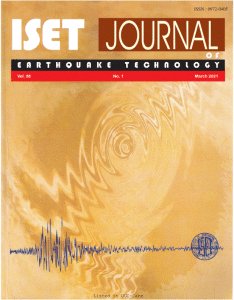Home > Issues & Journals
experimental investigations on masonry buildings strengthened using ferro-cement overlay under dynamic loading
Sachin B. Kadam and Yogendra Singh
Paper No.: 549
|
Vol.: 57
|
No.: 1
|
March, 2020
|
pp. 1-16

Abstract
Use of Ferro-cement (Welded Wire Mesh in cement concrete/mortar) ‘splints’ and ‘bandages’ is a common method of retrofitting unreinforced masonry (URM) buildings in India. Indian code IS:13935 [22] provides pre-computed amount of reinforcement to be provided in the splints and bandages in URM buildings located in active seismic areas. However, adequacy of this technique is not comprehensively studied so far. In this research paper, behaviour of a half-scale burnt clay brick unreinforced masonry building and another similar building but retrofitted using carried out on ‘Shock Table’ test facility available at Department of Earthquake Engineering, Indian Institute of Technology Roorkee. In this facility, an impact is applied at the base of the specimen. Short duration impulse types of motion are the main characteristics of shock table. It also has low frequency content and higher base acceleration with respect to real ground motion. The crack pattern, weaker zones and modes of failure with increasing intensity of shaking, have been presented and conclusions are drawn with respect to effectiveness of the used strengthening technique. Equivalent frame models (EFM) of the tested scaled models have been developed in SAP2000 Nonlinear software and the numerical results are compared with the prototype results. The results suggest that the lateral load resistance of the retrofitted building increases considerably, as compared to the URM buildings. The EFMs are able to predict the peak displacement, quite reasonably but fail to predict the response waveform.
Keywords: Unreinforced Brick Masonry; Shock Table Test; Wire-Mesh, Retrofit; Equivalent Frame Model
©2025. ISET. All Rights Reserved.